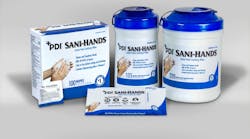New hand hygiene guidance supports efficacy of alcohol-based hand wipes
PDI Sani-Hands Instant Hand Sanitizing Wipes provide clinical efficacy as well as convenience for health-care workers and patients
New evidence-based recommendations released from the Society of Healthcare Epidemiology of America (SHEA) and the Infectious Disease Society of America (IDSA) recognize the clinical efficacy of alcohol-based hand wipes and their added benefit as “a convenient option for bed-bound patients, first responders, and others who cannot easily get to sinks or wall-mounted dispensers.” [3] The guideline, “Strategies to Prevent Healthcare-Associated Infections through Hand Hygiene,” (sic) was featured in the September 2014 issue of Infection Control and Hospital Epidemiology.
PDI, a leader in infection prevention solutions, offers Sani-Hands Instant Hand Sanitizing Wipes, the No. 1 hand sanitizing wipe in health-care and the only FDA-approved 70% alcohol-based hand sanitizing wipe following the FDA tentative monograph in the U.S. market. [2] The new recommendations represent a long-awaited update to the 2002 Guideline for Hand Hygiene in Health-Care Settings from the Centers for Disease Control and Prevention (CDC). In the past 10 years, clinical studies have reported alcohol-containing wipe formulations with at least 65% alcohol are comparable to alcohol-based hand rubs. [1]
“The acknowledgement of the clinical efficacy of alcohol-based wipe delivery systems is a positive change to practice guidelines for hand hygiene that will benefit both health-care providers as well as patients,” said J. Hudson Garrett Jr., PhD, MSN, MPH, FNP, CSRN, VA-BC, PLNC, the vice president of clinical Affairs for PDI. “Hand hygiene is identified by the CDC as the number one intervention against the transmission of Healthcare Associated Infections, and the inclusion of alcohol-based hand wipes in the new SHEA/IDSA Compendium will more make these hand hygiene solutions more broadly available for all healthcare environments, as well as patients.”
The clinical effectiveness of Sani-Hands wipes has been proven by several independent clinical studies. One study in a stem cell transplant unit demonstrated significant reductions in both Methicillin-resistant Staphylococcus aureus (MRSA) infection and vancomycin-resistant enterococci (VRE) infection, and elimination of carbapenem-resistant Enterobacteriaceae (CRE) infection in the unit. Additionally, patient satisfaction results identified:
- 93% of patients received hand product instruction;
- 98% of patients understood how and when to use the alcohol-based hand wipes;
- 95% of patients felt their hands were clean after using the alcohol-based hand wipes; and
- 75% of patients felt they cleaned their hands more often. [4]
Sani-HandsWipes have been clinically proven to kill 99.99% of germs and bacteria. Available in multiple formats, they are designed to address all hand hygiene needs throughout a facility and help reduce health-care-associated infections and associated costs. The Sani-Hands Instant Hand Sanitizing Wipes Bedside Pack specifically addresses the needs of bed-bound patients by delivering 20 wipes in a simple and convenient re-sealable pack that features intuitive educational “when-to-use” icons. Unlike gels and foams, the wiping action removes soil from the hands, leaving them feeling clean. The formulation also contains moisturizing aloe to help prevent drying of the skin. To complement its products, PDI delivers a suite of compliance accessories and educational tools for staff, patients and visitors including wall brackets, floor stands, and instructional patient education videos.
To find out more information, or to request a free trial, please visit pdihc.com/sani-hands.
[1] Strategies to Prevent Healthcare-Associated Infections through Hand Hygiene. Infection Control and Hospital Epidemiology, Vol. 35, No. S2, A Compendium of Strategies to Prevent Healthcare-associated Infections in Acute care Hospitals: 2014 Updates (September 2014), pp. S155-S178 http://www.jstor.org/stable/10.1086/677145#rid_rf116
[2] GHX Market Intelligence 2014
[3] Guideline for Hand Hygiene in Healthcare Settings. Recommendations of the Healthcare Infection Control Practices Advisory Committee and the HICPAC/SHEA/APIC/IDSA Hand Hygiene Task Force. Centers for Disease Control and Prevention. October 25, 2002. http://www.cdc.gov/handhygiene/Guidelines.html
[4] Reiner, S; Viall, A; Johnson, K; Walker, A: Enhanced Patient Hand-Hygiene in a Stem Cell Transplant Unit Reduces Multi-Drug Resistant Organism Prevalence, Abstract Presented at the 2013 Association for Professionals in Infection Control and Epidemiology Annual Conference.






